Can Combining Machine Learning Techniques and Remote Sensing Data Improve the Accuracy of Aboveground Biomass Estimations in Temperate Forests of Central Mexico?
Abstract
1. Introduction
2. Materials and Methods
2.1. Study Area
2.2. Forest Inventory Data
2.2.1. Forest Samples
2.2.2. Aboveground Biomass Estimations
| Allometric Model | Species | Source |
|---|---|---|
| Abies religiosa (Kunth) Schltdl. et. Cham. | [23] | |
| Pinus montezumae Lamb. | [24] | |
| Quercus sp. | [25] | |
| Arbutus xalapensis Kunth and Alnus firmifolia Fernald | [26] |
2.3. Remote Sensing Data
2.3.1. ALOS PALSAR
2.3.2. Sentinel-1
2.3.3. Landsat OLI
2.4. Modelling Spatial AGB
2.4.1. Linear Regression
2.4.2. Machine Learning Algorithms
Random Forest
XGBoost
2.5. Independent Assessment
3. Results
3.1. Forest Inventory Plots
3.2. Forest Census in One-Hectare Plots
3.3. Modelling Spatial Aboveground Biomass
3.3.1. Linear Regression Results
3.3.2. Machine Learning Algorithms
3.4. Performance Assessment with Independent Data
4. Discussion
5. Conclusions
Author Contributions
Funding
Institutional Review Board Statement
Informed Consent Statement
Data Availability Statement
Acknowledgments
Conflicts of Interest
References
- Reich, P.B.; Bolstad, P. Productivity of Evergreen and Deciduous Temperate Forests. In Terrestrial Global Productivity; Elsevier: Amsterdam, The Netherlands, 2001; pp. 245–283. [Google Scholar]
- Ávila-Akerberg, V.; Rosaliano-Evaristo, R.; González-Martínez, T.; Pichardo-García, B.; Serrano-González, D. Classification and Nomenclature of Temperate Forest Types in Mexico. Veg. Classif. Surv. 2023, 4, 329–341. [Google Scholar] [CrossRef]
- Canadell, J.G.; Schulze, E.D. Global Potential of Biospheric Carbon Management for Climate Mitigation. Nat. Commun. 2014, 5, 5282. [Google Scholar] [CrossRef] [PubMed]
- Law, B.E.; Hudiburg, T.W.; Berner, L.T.; Kent, J.J.; Buotte, P.C.; Harmon, M.E. Land Use Strategies to Mitigate Climate Change in Carbon Dense Temperate Forests. Proc. Natl. Acad. Sci. USA 2018, 115, 3663–3668. [Google Scholar] [CrossRef] [PubMed]
- Case, M.J.; Johnson, B.G.; Bartowitz, K.J.; Hudiburg, T.W. Forests of the Future: Climate Change Impacts and Implications for Carbon Storage in the Pacific Northwest, USA. For. Ecol. Manag. 2021, 482, 118886. [Google Scholar] [CrossRef]
- Kumar, L.; Sinha, P.; Taylor, S.; Alqurashi, A.F. Review of the Use of Remote Sensing for Biomass Estimation to Support Renewable Energy Generation. J. Appl. Remote Sens. 2015, 9, 097696. [Google Scholar] [CrossRef]
- Gómez, C.; White, J.C.; Wulder, M.A. Optical Remotely Sensed Time Series Data for Land Cover Classification: A Review. ISPRS J. Photogramm. Remote Sens. 2016, 116, 55–72. [Google Scholar] [CrossRef]
- Aziz, G.; Minallah, N.; Saeed, A.; Frnda, J.; Khan, W. Remote Sensing Based Forest Cover Classification Using Machine Learning. Sci. Rep. 2024, 14, 69. [Google Scholar] [CrossRef]
- Ortiz-Reyes, A.D.; Barrera-Ortega, D.; Velasco-Bautista, E.; Romero-Sánchez, M.E.; Correa-Díaz, A. Predicting Forest Parameters through Generalized Linear Mixed Models Using GEDI Metrics in a Temperate Forest in Oaxaca, Mexico. Int. J. Remote Sens. 2024, 45, 8037–8060. [Google Scholar] [CrossRef]
- Xu, D.; Wang, H.; Xu, W.; Luan, Z.; Xu, X. LiDAR Applications to Estimate Forest Biomass at Individual Tree Scale: Opportunities, Challenges and Future Perspectives. Forests 2021, 12, 550. [Google Scholar] [CrossRef]
- Coops, N.C. Characterizing Forest Growth and Productivity Using Remotely Sensed Data. Curr. For. Rep. 2015, 1, 195–205. [Google Scholar] [CrossRef]
- GOFC-GOLD. A Sourcebook of Methods and Procedures for Monitoring and Reporting Anthropogenic Greenhouse Gas Emissions and Removals Associated with Deforestation, Gains and Losses of Carbon Stocks in Forests Remaining Forests, and Forestation; Land Cover Project Office, Wageningen University: Wageningen, The Netherlands, 2015. [Google Scholar]
- Chen, L.; Ren, C.; Zhang, B.; Wang, Z.; Xi, Y. Estimation of Forest Above-Ground Biomass by Geographically Weighted Regression and Machine Learning with Sentinel Imagery. Forests 2018, 9, 582. [Google Scholar] [CrossRef]
- Issa, S.; Dahy, B.; Ksiksi, T.; Saleous, N. Non-Conventional Methods as a New Alternative for the Estimation of Terrestrial Biomass and Carbon Sequestered. World J. Agric. Soil Sci. 2019, 4, 1–8. [Google Scholar] [CrossRef]
- Luo, M.; Anees, S.A.; Huang, Q.; Qin, X.; Qin, Z.; Fan, J.; Han, G.; Zhang, L.; Shafri, H.Z.M. Improving Forest Above-Ground Biomass Estimation by Integrating Individual Machine Learning Models. Forests 2024, 15, 975. [Google Scholar] [CrossRef]
- Zhang, Y.; Ma, J.; Liang, S.; Li, X.; Li, M. An Evaluation of Eight Machine Learning Regression Algorithms for Forest Aboveground Biomass Estimation from Multiple Satellite Data Products. Remote Sens. 2020, 12, 4015. [Google Scholar] [CrossRef]
- Fan, D.; Biswas, A.; Ahrens, J.P. Explainable AI Integrated Feature Engineering for Wildfire Prediction. arXiv 2024, arXiv:2404.01487. [Google Scholar]
- Dittmann, S.; Thiessen, E.; Hartung, E. Applicability of Different Non-Invasive Methods for Tree Mass Estimation: A Review. For. Ecol. Manag. 2017, 398, 208–215. [Google Scholar] [CrossRef]
- Jensen, D.; Cavanaugh, K.C.; Simard, M.; Okin, G.S.; Castañeda-Moya, E.; McCall, A.; Twilley, R.R. Integrating Imaging Spectrometer and Synthetic Aperture Radar Data for Estimating Wetland Vegetation Aboveground Biomass in Coastal Louisiana. Remote Sens. 2019, 11, 2533. [Google Scholar] [CrossRef]
- Popescu, S.C. Estimating Biomass of Individual Pine Trees Using Airborne Lidar. Biomass Bioenergy 2007, 31, 646–655. [Google Scholar] [CrossRef]
- CONAFOR. National System of Forest Information: National Forest and Soils Inventory; CONAFOR: Zapopan, Mexico, 2012. [Google Scholar]
- Heris, M.P.; Bagstad, K.J.; Troy, A.R.; O’neil-Dunne, J.P.M. Assessing the Accuracy and Potential for Improvement of the National Land Cover Database’s Tree Canopy Cover Dataset in Urban Areas of the Conterminous United States. Remote Sens. 2022, 14, 1219. [Google Scholar] [CrossRef]
- Avendaño Hernandez, D.M.; Acosta Mireles, M.; Carrillo Anzures, F.; Etchevers Barra, J.D. Estimación de Biomasa y Carbono En Un Bosque de Abies Religiosa. Rev. Fitotec. Mex. 2009, 32, 233–238. [Google Scholar] [CrossRef]
- Carrillo Anzúres, F.; Acosta Mireles, M.; Flores Ayala, E.; Juárez Bravo, J.E.; Bonilla Padilla, E. Estimación de Biomasa y Carbono en dos Especies Arboreas en la Sierra Nevada, México. Rev. Mex. Cienc. Agric. 2018, 5, 779–793. [Google Scholar] [CrossRef]
- Ruiz-Aquino, F.; Valdez-Hernández, J.I.; Manzano-Méndez, F.; Rodríguez-Ortiz, G.; Romero-Manzanares, A.; Fuentes-López, M.E. Ecuaciones de Biomasa Aérea Para Quercus Laurina y Q. Crassifolia En Oaxaca. Madera Bosques 2014, 20, 33–48. [Google Scholar] [CrossRef]
- Aguilar-Hernández, L.; García-Martínez, R.; Gómez-Miraflor, A.; Martínez-Gómez, O. Estimación de Biomasa Mediante La Generación de Una Ecuación Alométrica Para Madroño (Arbutus xalapensis). In Proceedings of the IV Congreso Internacional y XVIII Congreso Nacional de Ciencias Agronómicas, Texcoco, Mexico, 20–22 April 2016; pp. 529–530. (In Spanish). [Google Scholar]
- Šmelko, Š.; Merganič, J. Some Methodological Aspects of the National Forest Inventory and Monitoring in Slovakia. J. For. Sci. 2008, 54, 476–483. [Google Scholar] [CrossRef]
- Ao, W.; Xu, F. Robust Ship Detection in SAR Images from Complex Background. In Proceedings of the 2018 IEEE International Conference on Computational Electromagnetics (ICCEM), Chengdu, China, 26–28 March 2018; IEEE: Piscataway, NJ, USA, 2018; pp. 1–2. [Google Scholar]
- Shimada, M.; Itoh, T.; Motooka, T.; Watanabe, M.; Shiraishi, T.; Thapa, R.; Lucas, R. New Global Forest/Non-Forest Maps from ALOS PALSAR Data (2007–2010). Remote Sens. Environ. 2014, 155, 13–31. [Google Scholar] [CrossRef]
- Duong-Nguyen, T.-B.; Hoang, T.-N.; Vo, P.; Le, H.-B. Water Level Estimation Using Sentinel-1 Synthetic Aperture Radar Imagery and Digital Elevation Models. arXiv 2020, arXiv:2012.07627. [Google Scholar]
- Hernández-Stefanoni, J.L.; Castillo-Santiago, M.Á.; Mas, J.F.; Wheeler, C.E.; Andres-Mauricio, J.; Tun-Dzul, F.; George-Chacón, S.P.; Reyes-Palomeque, G.; Castellanos-Basto, B.; Vaca, R.; et al. Improving Aboveground Biomass Maps of Tropical Dry Forests by Integrating LiDAR, ALOS PALSAR, Climate and Field Data. Carbon Balance Manag. 2020, 15, 15. [Google Scholar] [CrossRef]
- Imangholiloo, M.; Rasinmäki, J.; Rauste, Y.; Holopainen, M. Utilizing Sentinel-1A Radar Images for Large-Area Land Cover Mapping with Machine-Learning Methods. Can. J. Remote Sens. 2019, 45, 163–175. [Google Scholar] [CrossRef]
- Radočaj, D.; Obhođaš, J.; Jurišić, M.; Gašparović, M. Global Open Data Remote Sensing Satellite Missions for Land Monitoring and Conservation: A Review. Land 2020, 9, 402. [Google Scholar] [CrossRef]
- Kakoullis, D.; Fotiou, K.; Ibarrola Subiza, N.; Brcic, R.; Eineder, M.; Danezis, C. An Advanced Quality Assessment and Monitoring of ESA Sentinel-1 SAR Products via the CyCLOPS Infrastructure in the Southeastern Mediterranean Region. Remote Sens. 2024, 16, 1696. [Google Scholar] [CrossRef]
- Yan, L.; Roy, D.; Zhang, H.; Li, J.; Huang, H. An Automated Approach for Sub-Pixel Registration of Landsat-8 Operational Land Imager (OLI) and Sentinel-2 Multi Spectral Instrument (MSI) Imagery. Remote Sens. 2016, 8, 520. [Google Scholar] [CrossRef]
- Zhu, X.; Liu, D. Improving Forest Aboveground Biomass Estimation Using Seasonal Landsat NDVI Time-Series. ISPRS J. Photogramm. Remote Sens. 2015, 102, 222–231. [Google Scholar] [CrossRef]
- Huete, A.R. A Soil-Adjusted Vegetation Index (SAVI). Remote Sens. Environ. 1988, 25, 295–309. [Google Scholar] [CrossRef]
- Waring, R.H.; Coops, N.C.; Fan, W.; Nightingale, J.M. MODIS Enhanced Vegetation Index Predicts Tree Species Richness across Forested Ecoregions in the Contiguous U.S.A. Remote Sens. Environ. 2006, 103, 218–226. [Google Scholar] [CrossRef]
- Gao, B. NDWI—A Normalized Difference Water Index for Remote Sensing of Vegetation Liquid Water from Space. Remote Sens. Environ. 1996, 58, 257–266. [Google Scholar] [CrossRef]
- Camps-Valls, G.; Campos-Taberner, M.; Moreno-Martínez, Á.; Walther, S.; Duveiller, G.; Cescatti, A.; Mahecha, M.D.; Muñoz-Marí, J.; García-Haro, F.J.; Guanter, L.; et al. A Unified Vegetation Index for Quantifying the Terrestrial Biosphere. Sci. Adv. 2021, 7, eabc7447. [Google Scholar] [CrossRef]
- Wang, Q.; Moreno-Martínez, Á.; Muñoz-Marí, J.; Campos-Taberner, M.; Camps-Valls, G. Estimation of Vegetation Traits with Kernel NDVI. ISPRS J. Photogramm. Remote Sens. 2023, 195, 408–417. [Google Scholar] [CrossRef]
- R Core Team. R: A Language and Environment for Statistical Computing, version 4.1.0; R Foundation for Statistical Computing: Vienna, Austria, 2020. [Google Scholar]
- Romero-Sanchez, M.E.; Ponce-Hernandez, R. Assessing and Monitoring Forest Degradation in a Deciduous Tropical Forest in Mexico via Remote Sensing Indicators. Forests 2017, 8, 302. [Google Scholar] [CrossRef]
- Breiman, L. Random Forests. Mach. Learn. 2001, 45, 5–32. [Google Scholar] [CrossRef]
- Luan, J.; Zhang, C.; Xu, B.; Xue, Y.; Ren, Y. The Predictive Performances of Random Forest Models with Limited Sample Size and Different Species Traits. Fish Res. 2020, 227, 105534. [Google Scholar] [CrossRef]
- Chen, T.; Guestrin, C. Xgboost: A Scalable Tree Boosting System. In Proceedings of the 22nd ACM SIGKDD International Conference on Knowledge Discovery and Data Mining, San Francisco, CA, USA, 13–17 August 2016; pp. 785–794. [Google Scholar]
- Li, Y.; Li, M.; Li, C.; Liu, Z. Forest Aboveground Biomass Estimation Using Landsat 8 and Sentinel-1A Data with Machine Learning Algorithms. Sci. Rep. 2020, 10, 9952. [Google Scholar] [CrossRef]
- Rossiter, D.G. Spatial Analysis with the R Project for Statistical Computing; Cornell University: Wageningen, The Netherlands, 2008. [Google Scholar]
- Carlón Allende, T.; Mendoza, M.E.; Pérez-Salicrup, D.R.; Villanueva-Díaz, J.; Lara, A. Climatic Responses of Pinus Pseudostrobus and Abies Religiosa in the Monarch Butterfly Biosphere Reserve, Central Mexico. Dendrochronologia 2016, 38, 103–116. [Google Scholar] [CrossRef]
- Torres-Rojas, G.; Romero-Sánchez, M.E.; Velasco-Bautista, E.; González-Hernández, A. Estimación de Parámetros Forestales En Bosques de Coníferas Con Técnicas de Percepción Remota. Rev. Mex. Cienc. For. 2016, 7, 7–24. [Google Scholar]
- Moreno-Fernández, D.; Cañellas, I.; Hernández, L.; Adame, P.; Alberdi, I. Nested Plot Designs Used in Forest Inventory Do Not Accurately Capture Tree Species Richness in Southwestern European Forests. Ann. For. Sci. 2024, 81, 20. [Google Scholar] [CrossRef]
- Shendryk, Y. Fusing GEDI with Earth Observation Data for Large Area Aboveground Biomass Mapping. Int. J. Appl. Earth Obs. Geoinf. 2022, 115, 103108. [Google Scholar] [CrossRef]
- Wulder, M.A.; Hermosilla, T.; White, J.C.; Coops, N.C. Biomass Status and Dynamics over Canada’s Forests: Disentangling Disturbed Area from Associated Aboveground Biomass Consequences. Environ. Res. Lett. 2020, 15, 094093. [Google Scholar] [CrossRef]
- Häme, T.; Rauste, Y.; Antropov, O.; Ahola, H.A.; Kilpi, J. Improved Mapping of Tropical Forests with Optical and Sar Imagery, Part Ii: Above Ground Biomass Estimation. IEEE J. Sel. Top. Appl. Earth Obs. Remote Sens. 2013, 6, 92–101. [Google Scholar] [CrossRef]
- Urbazaev, M.; Thiel, C.; Cremer, F.; Dubayah, R.; Migliavacca, M.; Reichstein, M.; Schmullius, C. Estimation of Forest Aboveground Biomass and Uncertainties by Integration of Field Measurements, Airborne LiDAR, and SAR and Optical Satellite Data in Mexico. Carbon Balance Manag. 2018, 13, 5. [Google Scholar] [CrossRef]
- Schwartz, M.; Ciais, P.; Ottlé, C.; De Truchis, A.; Vega, C.; Fayad, I.; Brandt, M.; Fensholt, R.; Baghdadi, N.; Morneau, F.; et al. High-Resolution Canopy Height Map in the Landes Forest (France) Based on GEDI, Sentinel-1, and Sentinel-2 Data with a Deep Learning Approach. Int. J. Appl. Earth Obs. Geoinf. 2024, 128, 103711. [Google Scholar] [CrossRef]
- Cartus, O.; Kellndorfer, J.; Walker, W.; Franco, C.; Bishop, J.; Santos, L.; Fuentes, J. A National, Detailed Map of Forest Aboveground Carbon Stocks in Mexico. Remote Sens. 2014, 6, 5559–5588. [Google Scholar] [CrossRef]
- Rosas-Chavoya, M.; López-Serrano, P.M.; Vega-Nieva, D.J.; Hernández-Díaz, J.C.; Wehenkel, C.; Corral-Rivas, J.J. Estimating Above-Ground Biomass from Land Surface Temperature and Evapotranspiration Data at the Temperate Forests of Durango, Mexico. Forests 2023, 14, 299. [Google Scholar] [CrossRef]
- Zolkos, S.G.; Goetz, S.J.; Dubayah, R. A Meta-Analysis of Terrestrial Aboveground Biomass Estimation Using Lidar Remote Sensing. Remote Sens. Environ. 2013, 128, 289–298. [Google Scholar] [CrossRef]
- Jin, Y.; Yang, X.; Qiu, J.; Li, J.; Gao, T.; Wu, Q.; Zhao, F.; Ma, H.; Yu, H.; Xu, B. Remote Sensing-Based Biomass Estimation and Its Spatio-Temporal Variations in Temperate Grassland, Northern China. Remote Sens. 2014, 6, 1496–1513. [Google Scholar] [CrossRef]
- Bhandari, A.K.; Kumar, A.; Singh, G.K. Feature Extraction Using Normalized Difference Vegetation Index (NDVI): A Case Study of Jabalpur City. Procedia Technol. 2012, 6, 612–621. [Google Scholar] [CrossRef]
- Xu, H.; Yin, H.; Liu, J.; Wang, L.; Feng, W.; Song, H.; Fan, Y.; Qi, K.; Liang, Z.; Li, W.; et al. Prediction of Spatial Winter Wheat Yield by Combining Multiscale Time Series of Vegetation and Meteorological Indices. Agronomy 2025, 15, 1114. [Google Scholar] [CrossRef]
- Xu, L.; Saatchi, S.S.; Yang, Y.; Yu, Y.; White, L. Performance of Non-Parametric Algorithms for Spatial Mapping of Tropical Forest Structure. Carbon Balance Manag. 2016, 11, 18. [Google Scholar] [CrossRef]
- Hensley, S.; Oveisgharan, S.; Saatchi, S.; Simard, M.; Ahmed, R.; Haddad, Z. An Error Model for Biomass Estimates Derived from Polarimetric Radar Backscatter. IEEE Trans. Geosci. Remote Sens. 2014, 52, 4065–4082. [Google Scholar] [CrossRef]
- Huang, H.; Liu, C.; Wang, X.; Zhou, X.; Gong, P. Integration of Multi-Resource Remotely Sensed Data and Allometric Models for Forest Aboveground Biomass Estimation in China. Remote Sens. Environ. 2019, 221, 225–234. [Google Scholar] [CrossRef]
- Tian, L.; Wu, X.; Tao, Y.; Li, M.; Qian, C.; Liao, L.; Fu, W. Review of Remote Sensing-Based Methods for Forest Aboveground Biomass Estimation: Progress, Challenges, and Prospects. Forests 2023, 14, 1086. [Google Scholar] [CrossRef]
- Li, Y.; Li, M.; Wang, Y. Forest Aboveground Biomass Estimation and Response to Climate Change Based on Remote Sensing Data. Sustainability 2022, 14, 14222. [Google Scholar] [CrossRef]
- Zhang, Y.; Liang, S.; Yang, L. A Review of Regional and Global Gridded Forest Biomass Datasets. Remote Sens. 2019, 11, 2744. [Google Scholar] [CrossRef]
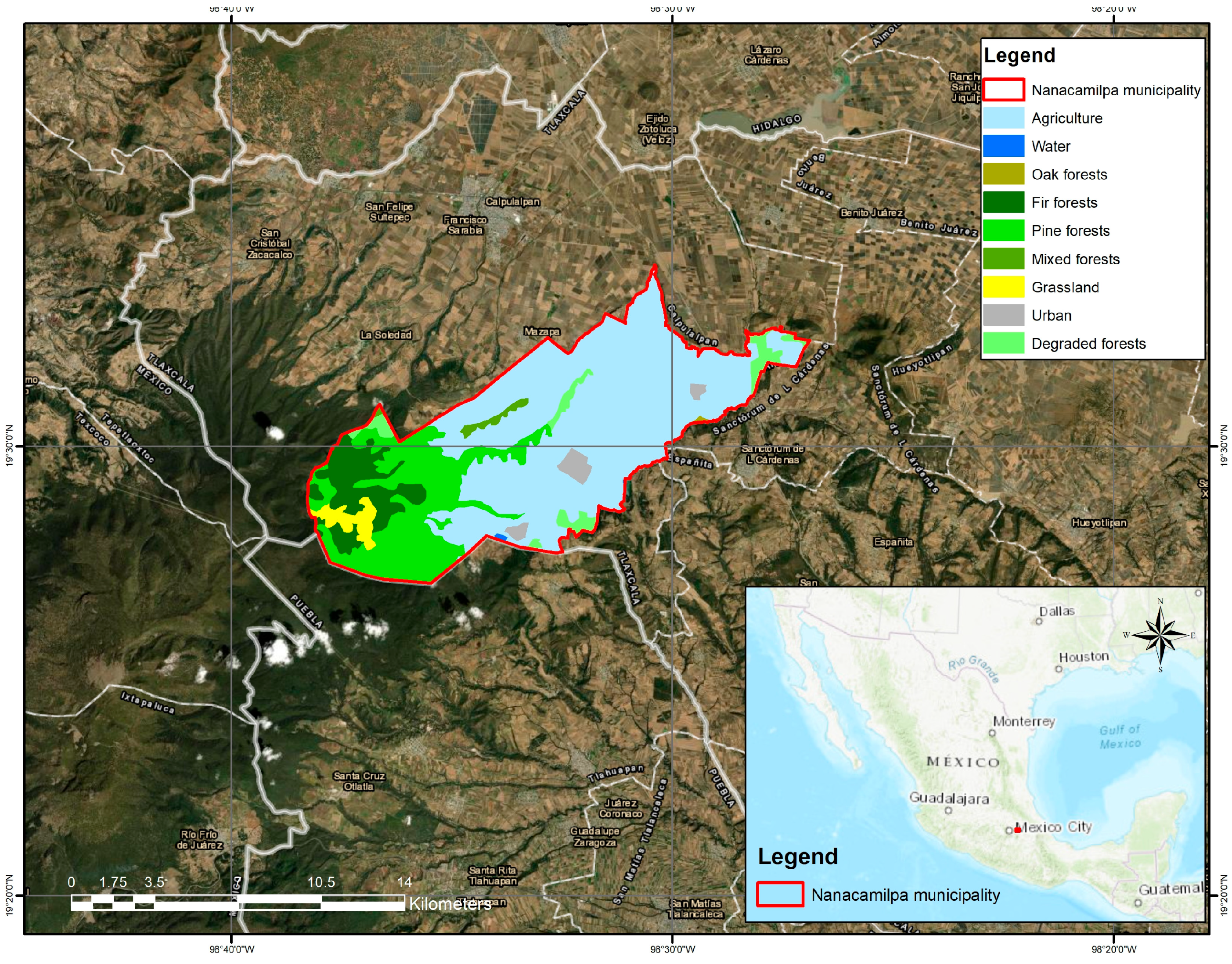


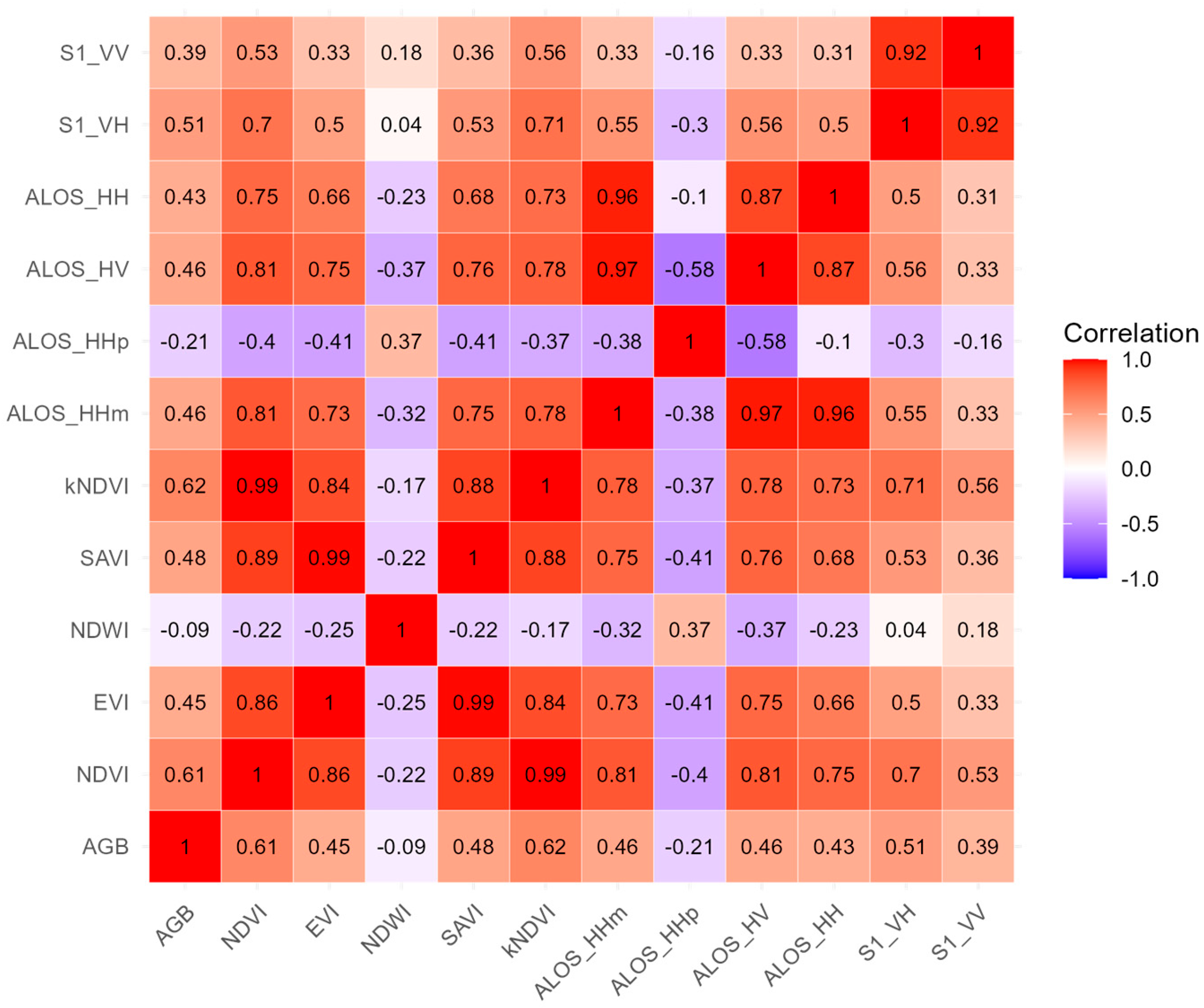
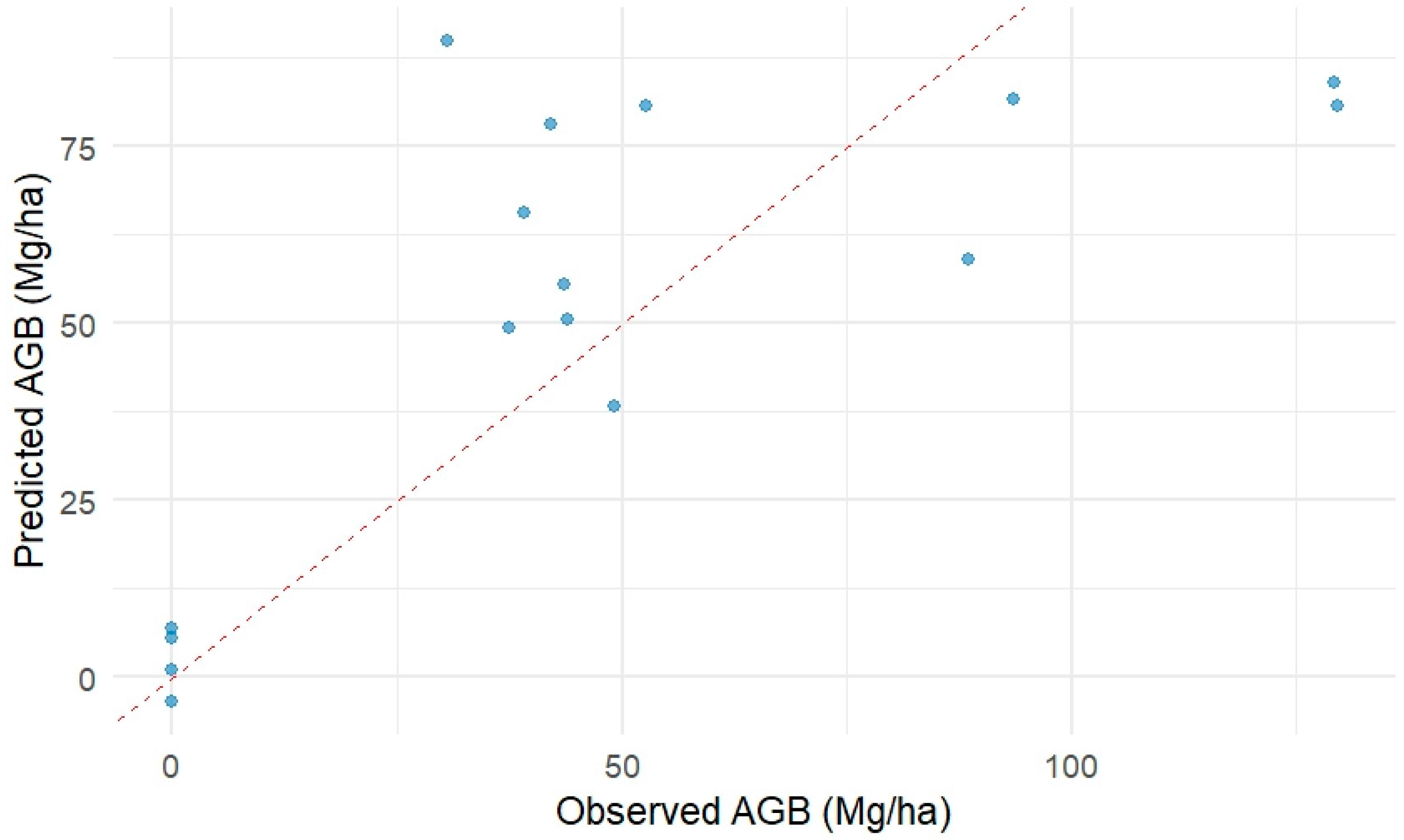
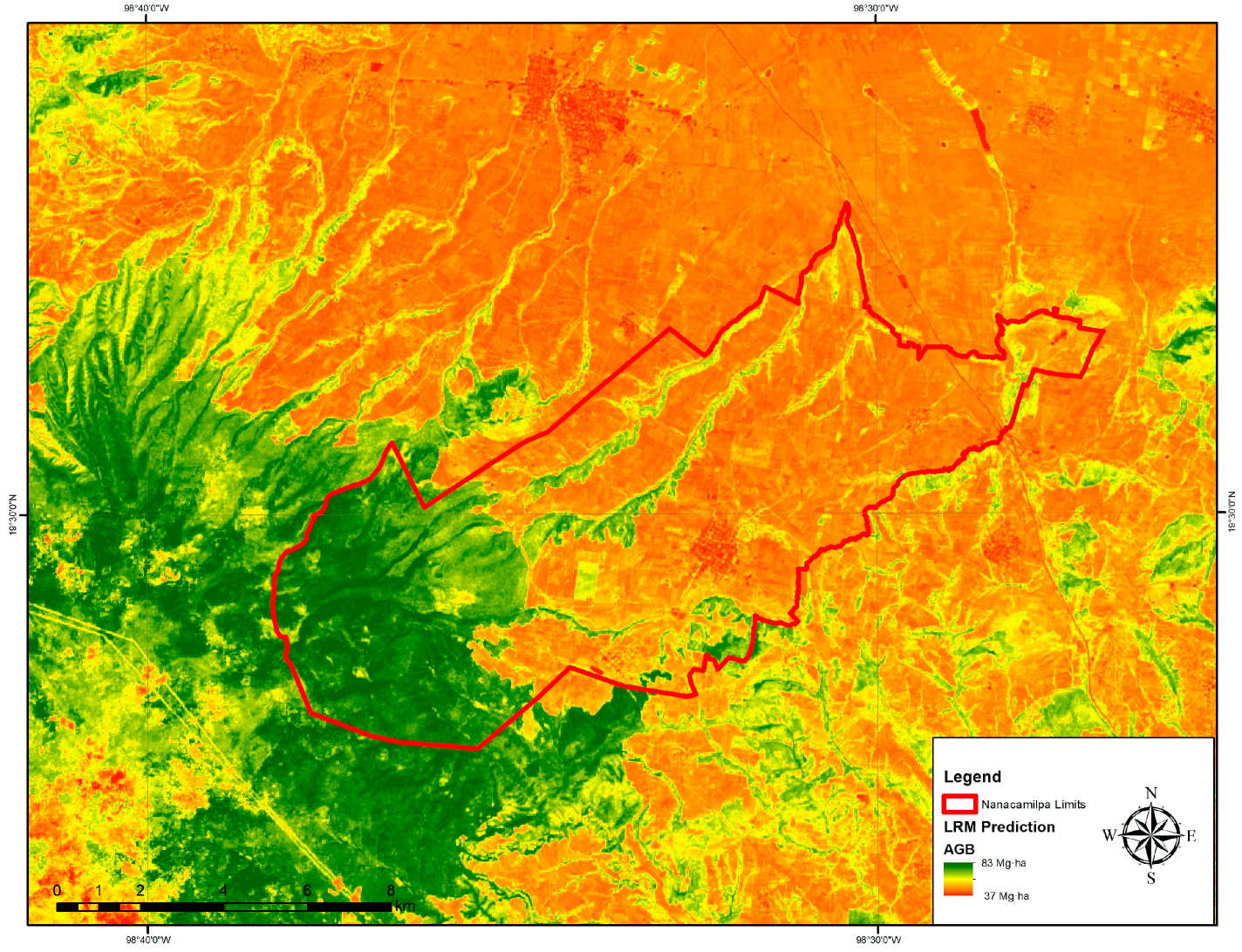



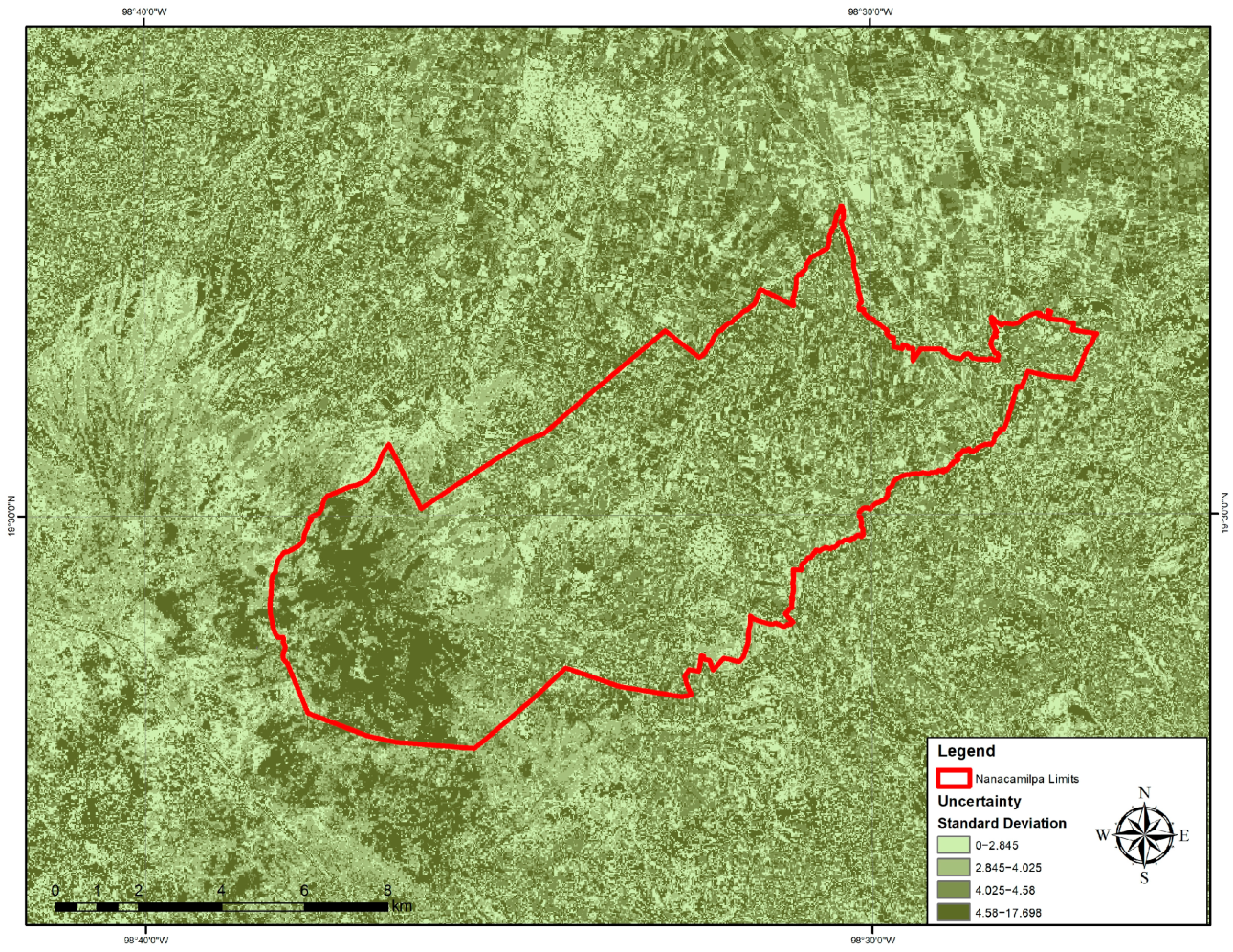
| Sensor | Layer |
|---|---|
| ALOS PALSAR | HH, HH+HV, HH-HV, HV |
| Sentinel 1 | VH, VV, VV+VH, V-VH |
| Landsat OLI | NDVI, EVI, SAVI, NDWI, kNDVI |
| Coefficients | Estimate | Std. Error | t-Value | Pr (>|t|) |
|---|---|---|---|---|
| Intercept | 53.742 | 4.249 | 12.65 | <0.001 |
| kNDVI | 23.811 | 4.148 | 5.74 | <0.001 |
| Model | R2cv | RMSEcv (Mg ha−1) |
|---|---|---|
| Random Forest | 0.54 | 19.17 |
| XGBoost | 0.39 | 26.32 |
| Plot | AGB (Measured) | LM | Ensembled | Random Forest | XGBoost |
|---|---|---|---|---|---|
| Mg ha−1 | |||||
| 1 | 198.47 | 77.42 | 75.56 | 72.18 | 78.94 |
| 2 | 84.43 | 75.54 | 73.51 | 70.24 | 76.77 |
| 3 | 154.64 | 80.05 | 76.75 | 73.47 | 80.04 |
| 4 | 164.03 | 74.82 | 73.91 | 71.05 | 76.77 |
| 5 | 111.65 | 73.68 | 73.69 | 70.62 | 76.76 |
| 6 | 73.11 | 72.85 | 73.79 | 70.82 | 76.76 |
| 7 | 142.32 | 72.67 | 73.79 | 70.82 | 76.76 |
| 8 | 105.58 | 73.88 | 73.78 | 70.79 | 76.76 |
| 9 | 102.17 | 72.80 | 70.40 | 71.67 | 69.13 |
| 11 | 142.16 | 78.81 | 75.77 | 72.61 | 78.94 |
| 12 | 219.40 | 77.68 | 75.43 | 71.93 | 78.94 |
| S | 0.50 | 0.68 | 0.59 | 0.64 | |
| RMSE | 74.17 | 75.50 | 77.99 | 73.05 | |
| MAE | 60.70 | 62.08 | 64.70 | 58.88 | |
Disclaimer/Publisher’s Note: The statements, opinions and data contained in all publications are solely those of the individual author(s) and contributor(s) and not of MDPI and/or the editor(s). MDPI and/or the editor(s) disclaim responsibility for any injury to people or property resulting from any ideas, methods, instructions or products referred to in the content. |
© 2025 by the authors. Licensee MDPI, Basel, Switzerland. This article is an open access article distributed under the terms and conditions of the Creative Commons Attribution (CC BY) license (https://creativecommons.org/licenses/by/4.0/).
Share and Cite
Romero-Sanchez, M.E.; Gonzalez-Hernandez, A.; Velasco-Bautista, E.; Correa-Diaz, A.; Ortiz-Reyes, A.D.; Perez-Miranda, R. Can Combining Machine Learning Techniques and Remote Sensing Data Improve the Accuracy of Aboveground Biomass Estimations in Temperate Forests of Central Mexico? Geomatics 2025, 5, 30. https://doi.org/10.3390/geomatics5030030
Romero-Sanchez ME, Gonzalez-Hernandez A, Velasco-Bautista E, Correa-Diaz A, Ortiz-Reyes AD, Perez-Miranda R. Can Combining Machine Learning Techniques and Remote Sensing Data Improve the Accuracy of Aboveground Biomass Estimations in Temperate Forests of Central Mexico? Geomatics. 2025; 5(3):30. https://doi.org/10.3390/geomatics5030030
Chicago/Turabian StyleRomero-Sanchez, Martin Enrique, Antonio Gonzalez-Hernandez, Efraín Velasco-Bautista, Arian Correa-Diaz, Alma Delia Ortiz-Reyes, and Ramiro Perez-Miranda. 2025. "Can Combining Machine Learning Techniques and Remote Sensing Data Improve the Accuracy of Aboveground Biomass Estimations in Temperate Forests of Central Mexico?" Geomatics 5, no. 3: 30. https://doi.org/10.3390/geomatics5030030
APA StyleRomero-Sanchez, M. E., Gonzalez-Hernandez, A., Velasco-Bautista, E., Correa-Diaz, A., Ortiz-Reyes, A. D., & Perez-Miranda, R. (2025). Can Combining Machine Learning Techniques and Remote Sensing Data Improve the Accuracy of Aboveground Biomass Estimations in Temperate Forests of Central Mexico? Geomatics, 5(3), 30. https://doi.org/10.3390/geomatics5030030








